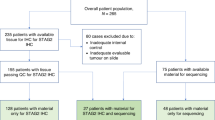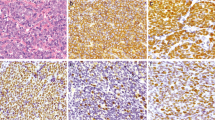Abstract
Ewing sarcoma (ES) is an aggressive neoplasm with variable morphology. It has no specific immunoprofile or molecular signature. Neither CD99, NKX2.2 nor PAX7 immunoreactivity alone is completely specific, although diagnostic specificity improves when combined. The purpose of the present study was to investigate the immunohistochemical (IHC) expression of PAX7 in a large series of genetically confirmed ES. Existing results for CD99 and NKX2.2 immunoexpression, morphological findings and molecular studies (fusion gene subtypes) were retrieved from a previous study. Survival analyses were performed in cases with available clinical follow-up. PAX7 was positive in 95.5% of ES with diffuse staining (> 50%) in all positive cases and moderate or strong intensity for most cases. Nineteen ES displayed both PAX7 and CD99 immunoreactivity but lacked NKX2.2 immunoexpression. No relationships could be found between PAX7 expression and the histological types or ES gene fusion subtypes. Univariant/multivariate analysis showed that lack of PAX7 and/or NKX2.2 immunoexpression constitute independent poor prognostic factors for progression free survival (PFS) and overall survival (OS). In conclusion, IHC for CD99, NKX2.2, and PAX7 may be useful in daily practice for ES diagnosis, particularly in hospitals lacking facilities for molecular studies. In addition, the combination of strong CD99 membranous positivity and nuclear PAX7 and NKX2.2 immunoreactivity seems to be very reliable for ES diagnosis when supported by a corroborating histomorphologic and clinical picture. Although PAX7 is not entirely specific for ES, it seems to have a more extensive and strong nuclear immunoreactivity than NKX2.2 expression, even in tumors with decalcification artifact. Considering the prognostically significant data herein reported, we strongly recommend validation in prospective ES series that include localized and disseminated tumors.





Similar content being viewed by others
Data availability
The datasets generated during and/or analyzed during the current study are available from the corresponding author on reasonable request.
The study was conducted according to the guidelines of the Declaration of Helsinki and approved by the Local Ethics Committees.
References
de Alava E (2017) Ewing sarcoma, an update on molecular pathology with therapeutic implications. Surg Pathol Clin 10(3):575–585. https://doi.org/10.1016/j.path.2017.04.001
Zöllner SK, Amatruda JF, Bauer S, Collaud S, de Álava E, DuBois SG, Hardes J, Hartmann W, Kovar H, Metzler M, Shulman DS, Streitbürger A, Timmermann B, Toretsky JA, Uhlenbruch Y, Vieth V, Grünewald TGP, Dirksen U (2021) Ewing sarcoma-diagnosis, treatment, clinical challenges and future perspectives. J Clin Med 14;10(8):1685. https://doi.org/10.3390/jcm10081685
Osuna D, de Alava E (2009) Molecular pathology of sarcomas. Rev Recent Clin Trials 4(1):12–26. https://doi.org/10.2174/157488709787047585
Kovar H, Alonso J, Aman P, Aryee DN, Ban J, Burchill SA, Burdach S, De Alava E, Delattre O, Dirksen U, Fourtouna A, Fulda S, Helman LJ, Herrero-Martin D, Hogendoorn PC, Kontny U, Lawlor ER, Lessnick SL, Llombart-Bosch A, Metzler M, Moriggl R, Niedan S, Potratz J, Redini F, Richter GH, Riedmann LT, Rossig C, Schäfer BW, Schwentner R, Scotlandi K, Sorensen PH, Staege MS, Tirode F, Toretsky J, Ventura S, Eggert A, Ladenstein R (2012) The first European interdisciplinary Ewing sarcoma research summit. Front Oncol 29(2):54. https://doi.org/10.3389/fonc.2012.00054
Ordóñez JL, Osuna D, García-Domínguez DJ, Amaral AT, Otero-Motta AP, Mackintosh C, Sevillano MV, Barbado MV, Hernández T, de Alava E (2010) The clinical relevance of molecular genetics in soft tissue sarcomas. Adv Anat Pathol 17(3):162–181. https://doi.org/10.1097/PAP.0b013e3181d98cbf
Ginsberg JP, de Alava E, Ladanyi M, Wexler LH, Kovar H, Paulussen M, Zoubek A, Dockhorn-Dworniczak B, Juergens H, Wunder JS, Andrulis IL, Malik R, Sorensen PH, Womer RB, Barr FG (1999) EWS-FLI1 and EWS-ERG gene fusions are associated with similar clinical phenotypes in Ewing’s sarcoma. J Clin Oncol 17(6):1809–1814. https://doi.org/10.1200/JCO.1999.17.6.1809
Díaz-Martín J, Biscuola M, Benoit J, Marcilla D, Civantos G, de Álava E (2019) What’s in a name? Molecular subclassification of sarcomas creates fresh challenges. J Pathol 247(4):409–412
Jahanseir K, Folpe AL, Graham RP, Giannini C, Robinson SI, Sukov W, Fritchie K (2020) Ewing sarcoma in older adults: a clinicopathologic study of 50 cases occurring in patients aged ≥ 40 years, with emphasis on histologic mimics. Int J Surg Pathol 28(4):352–360. https://doi.org/10.1177/1066896919893073
Kavalar R, Pohar Marinsek Z, Jereb B, Cagran B, Golouh R (2009) Prognostic value of immunohistochemistry in the Ewing’s sarcoma family of tumors. Med Sci Monit 15(8):CR442–52.
Kilpatrick SE, Reith JD, Rubin B (2018) Ewing sarcoma and the history of similar and possibly related small round cell tumors: from whence have we come and where are we going? Adv Anat Pathol 25(5):314–326. https://doi.org/10.1097/PAP.0000000000000203
WHO Classification of Tumours Editorial Board eds (2020) World Health Organization classification of soft tissue and bone tumours. 5th ed. Lyon: IARC.
Sbaraglia M, Righi A, Gambarotti M, Dei Tos AP (2020) Ewing sarcoma and Ewing-like tumors. Virchows Arch 476(1):109–119
Anderson WJ, Doyle LA (2021) Updates from the 2020 World Health Organization classification of soft tissue and bone tumours. Histopathology 78(5):644–657. https://doi.org/10.1111/his.14265
Llombart-Bosch A, Machado I, Navarro S, Bertoni F, Bacchini P, Alberghini M, Karzeladze A, Savelov N, Petrov S, Alvarado-Cabrero I, Mihaila D, Terrier P, Lopez-Guerrero JA (2009) Picci P (2009) Histological heterogeneity of Ewing’s sarcoma/PNET: an immunohistochemical analysis of 415 genetically confirmed cases with clinical support. Virchows Arch 455(5):397–411. https://doi.org/10.1007/s00428-009-0842-7
López-Guerrero JA, Machado I, Scotlandi K, Noguera R, Pellín A, Navarro S, Serra M, Calabuig-Fariñas S, Picci P, Llombart-Bosch A (2011) Clinicopathological significance of cell cycle regulation markers in a large series of genetically confirmed Ewing’s sarcoma family of tumors. Int J Cancer 128(5):1139–1150. https://doi.org/10.1002/ijc.25424
Yoshida A, Sekine S, Tsuta K, Fukayama M, Furuta K, Tsuda H (2012) NKX2.2 is a useful immunohistochemical marker for Ewing sarcoma. Am J Surg Pathol 36(7):993–9. https://doi.org/10.1097/PAS.0b013e31824ee43c.
Rooper LM, Sharma R, Gocke CD, Belchis DA (2019) The utility of NKX2.2 and TLE1 immunohistochemistry in the differentiation of Ewing sarcoma and synovial sarcoma. Appl Immunohistochem Mol Morphol 27(3):174–179. https://doi.org/10.1097/PAI.0000000000000573
Russell-Goldman E, Hornick JL, Qian X, Jo VY (2018) NKX2.2 immunohistochemistry in the distinction of Ewing sarcoma from cytomorphologic mimics: diagnostic utility and pitfalls. Cancer Cytopathol 126(11):942–949. https://doi.org/10.1002/cncy.22056
McCuiston A, Bishop JA (2028) Usefulness of NKX2.2 immunohistochemistry for distinguishing Ewing sarcoma from other sinonasal small round blue cell tumors. Head Neck Pathol 12(1):89–94. https://doi.org/10.1007/s12105-017-0830-1
Shibuya R, Matsuyama A, Nakamoto M, Shiba E, Kasai T, Hisaoka M (2014) The combination of CD99 and NKX2.2, a transcriptional target of EWSR1-FLI1, is highly specific for the diagnosis of Ewing sarcoma. Virchows Arch 465(5):599–605. doi: https://doi.org/10.1007/s00428-014-1627-1.
Machado I, Yoshida A, López-Guerrero JA, Nieto MG, Navarro S, Picci P, Llombart-Bosch A (2017) Immunohistochemical analysis of NKX2.2, ETV4, and BCOR in a large series of genetically confirmed Ewing sarcoma family of tumors. Pathol Res Pract 213(9):1048–1053. doi: https://doi.org/10.1016/j.prp.2017.08.002.
Toki S, Wakai S, Sekimizu M, Mori T, Ichikawa H, Kawai A, Yoshida A (2018) PAX7 immunohistochemical evaluation of Ewing sarcoma and other small round cell tumours. Histopathology 73(4):645–652. https://doi.org/10.1111/his.13689
Charville GW, Wang WL, Ingram DR, Roy A, Thomas D, Patel RM, Hornick JL, van de Rijn M, Lazar AJ (2019) PAX7 expression in sarcomas bearing the EWSR1-NFATC2 translocation. Mod Pathol 32(1):154–156. https://doi.org/10.1038/s41379-018-0095-6
Charville GW, Wang WL, Ingram DR, Roy A, Thomas D, Patel RM, Hornick JL, van de Rijn M, Lazar AJ (2017) EWSR1 fusion proteins mediate PAX7 expression in Ewing sarcoma. Mod Pathol 30(9):1312–1320. https://doi.org/10.1038/modpathol.2017.49
Fernandez-Pol S, van de Rijn M, Natkunam Y, Charville GW (2018) Immunohistochemistry for PAX7 is a useful confirmatory marker for Ewing sarcoma in decalcified bone marrow core biopsy specimens. Virchows Arch 473(6):765–769. https://doi.org/10.1007/s00428-018-2410-5
Charville GW, Varma S, Forgó E, Dumont SN, Zambrano E, Trent JC, Lazar AJ, van de Rijn M (2016) PAX7 expression in rhabdomyosarcoma, related soft tissue tumors, and small round blue cell neoplasms. Am J Surg Pathol 40(10):1305–1315. https://doi.org/10.1097/PAS.0000000000000717
Baldauf MC, Gerke JS, Orth MF, Dallmayer M, Baumhoer D, de Alava E, Hartmann W, Kirchner T, Grünewald TGP (2018) Are EWSR1-NFATc2-positive sarcomas really Ewing sarcomas? Mod Pathol 31(6):997–999. https://doi.org/10.1038/s41379-018-0009-7
Hung YP, Fletcher CD, Hornick JL (2016) Evaluation of NKX2-2 expression in round cell sarcomas and other tumors with EWSR1 rearrangement: imperfect specificity for Ewing sarcoma. Mod Pathol 29(4):370–380. https://doi.org/10.1038/modpathol.2016.31
Ribeiro-Dantas MDC, Oliveira Imparato D, Dalmolin MGS, de Farias CB, Brunetto AT, da Cunha JM, Roesler R, Sinigaglia M, Siqueira Dalmolin RJ (2021) Reverse engineering of Ewing sarcoma regulatory network uncovers PAX7 and RUNX3 as master regulators associated with good prognosis. Cancers (Basel) 13(8):1860. https://doi.org/10.3390/cancers13081860
McBride MJ, Pulice JL, Beird HC, Ingram DR, D’Avino AR, Shern JF, Charville GW, Hornick JL, Nakayama RT, Garcia-Rivera EM, Araujo DM, Wang WL, Tsai JW, Yeagley M, Wagner AJ, Futreal PA, Khan J, Lazar AJ, Kadoch C (2018) The SS18-SSX fusion oncoprotein hijacks BAF complex targeting and function to drive synovial sarcoma. Cancer Cell 33(6):1128-1141.e7. https://doi.org/10.1016/j.ccell.2018.05.002
Yoshida KI, Machado I, Motoi T, Parafioriti A, Lacambra M, Ichikawa H, Kawai A, Antonescu CR, Yoshida A (2020) NKX3-1 is a useful immunohistochemical marker of EWSR1-NFATC2 sarcoma and mesenchymal chondrosarcoma. Am J Surg Pathol 44(6):719–728. https://doi.org/10.1097/PAS.0000000000001441
Qian W, Li Q, Wu X, Li W, Li Q, Zhang J, Li M, Zhang D, Zhao H, Zou X, Jia H, Zhang L, Yang XD, Hou Z (2020) Deubiquitinase USP29 promotes gastric cancer cell migration by cooperating with phosphatase SCP1 to stabilize Snail protein. Oncogene 39(44):6802–6815. https://doi.org/10.1038/s41388-020-01471-0
Sharili AS, Allen S, Smith K, Hargreaves J, Price J, McGonnell I (2011) Expression of Snail2 in long bone osteosarcomas correlates with tumour malignancy. Tumour Biol 32(3):515–526. https://doi.org/10.1007/s13277-010-0146-1
Machado I, López-Guerrero JA, Navarro S, Alberghini M, Scotlandi K, Picci P, Llombart-Bosch A (2012) Epithelial cell adhesion molecules and epithelial mesenchymal transition (EMT) markers in Ewing’s sarcoma family of tumors (ESFTs). Do they offer any prognostic significance? Virchows Arch 461(3):333–7. DOI: https://doi.org/10.1007/s00428-012-1288-x
Acknowledgements
This study was supported by prognostic and therapeutic targets in the Ewing’s family of tumors, contract 503036, and EuroBoNet, European network to promote research into uncommon cancers in adults and children, contract 018814. The authors thank David Harrison for the English review and editing of the manuscript.
Author information
Authors and Affiliations
Contributions
Conceptualization: IM and AL-B; methodology: IM and JALG; formal analysis and investigation: IM, GWC, JALG, and AL-B; writing — original draft preparation: IM; writing — review and editing: IM, GWC, SN, AY, KS, MG, and AR; and supervision: AL-B.
Corresponding author
Ethics declarations
Conflicts of interest
The authors declare no competing interests.
Additional information
Publisher's note
Springer Nature remains neutral with regard to jurisdictional claims in published maps and institutional affiliations.
Rights and permissions
About this article
Cite this article
Machado, I., Charville, G.W., Yoshida, A. et al. Does PAX7 and NKX2.2 immunoreactivity in Ewing sarcoma have prognostic significance?. Virchows Arch 480, 909–917 (2022). https://doi.org/10.1007/s00428-021-03254-8
Received:
Revised:
Accepted:
Published:
Issue Date:
DOI: https://doi.org/10.1007/s00428-021-03254-8




